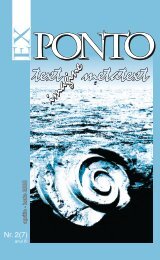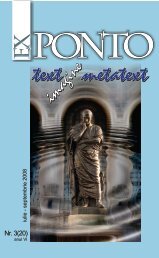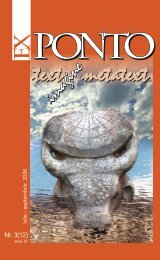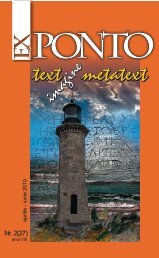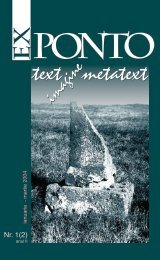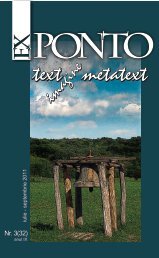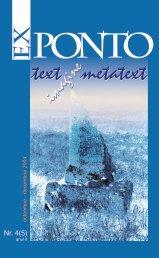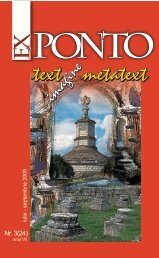Nr. 4 (21) anul VI / octombrie-decembrie 2008 - ROMDIDAC
Nr. 4 (21) anul VI / octombrie-decembrie 2008 - ROMDIDAC
Nr. 4 (21) anul VI / octombrie-decembrie 2008 - ROMDIDAC
You also want an ePaper? Increase the reach of your titles
YUMPU automatically turns print PDFs into web optimized ePapers that Google loves.
EX PONTO NR.4, <strong>2008</strong><br />
114<br />
under the Romanian exotic attire. Matisse’s fascination with Romanian<br />
costumes was an aesthetic reaction in front of an artistic work. In a letter to<br />
his life-time friend Theodor Pallady, he admitted that these artifacts had as<br />
much value as the artworks in which they are depicted:<br />
I found a beautiful Romanian blouse, of ancient design, with old ochre<br />
stitches, that must have belonged to a princess and I’d like many more of<br />
them, for which I’d willingly exchange a fine drawing. (187)<br />
Matisse’s blouses became so popular in the US that during the 1940s a<br />
Hungarian expatriate, De Hory/Raynal/von Houry/Herzog/Cassou/Hoffman/<br />
Dory-Boutin, forged hundreds of Matisse’s drawings depicting women wearing<br />
Romanian blouses. That is relevant both for the American market of artworks<br />
and for the interest in the Romanian decorative patterns. The fact that these<br />
fake drawings were distributed by dealers from New York and Chicago is also<br />
significant for the Romanian settlements and the increased interest in their<br />
identity as represented in high art.<br />
Constantin Brâncu[i<br />
In the first two decades of the twentieth century, two important exhibitions<br />
made the news for several months in the East Coast, drawing the American<br />
public’s attention to the artworks of a Romanian sculptor, Constantin Brâncu[i.<br />
At the Armory Show, New York 1913, Brâncu[i exhibited five pieces which<br />
attracted American collectors and some of the American art critics. Articles<br />
in New York Times, The Sun, and New York Press were about Brâncu[i’s<br />
art and his Romanian roots. Camera Work, Little Review, Vanity Fair, New<br />
York Times, The New York Evening Post accompanied their articles about<br />
Brâncu[i with photos of his Birds. The interest of the media in this topic was<br />
so high that the editors of This Quarter considered Brâncu[i to be “the most<br />
written-about artist in the world.” Ezra Pound, 8 Mina Loy, and Jeanne Foster<br />
wrote about Brâncu[i’s Romanian heritage and its traces in his artworks,<br />
mainly primitivism.<br />
The most publicized event was, however, the celebrated trial, American<br />
Customs versus Brâncu[i. On October 1927, the customs officer declared<br />
Brâncu[i’s modernist bronze sculptures “Kitchen utensil and Hospital Supplies”<br />
and charged him a $ 4,000 fee for his “raw” metal works, oblivious to their<br />
artistic value. Besides the two parties, the US government and the avantgarde<br />
sculptor, an impressive number of American and European artists as<br />
well as art critics were involved as experts. The sculptor, Jacob Epstein;<br />
the photographer, Edward Steichen; the editor of The Arts, Forbes Watson;<br />
the editor of Vanity Fair, Frank Crowninshield; the director of the Brooklyn<br />
Museum of Art, William Henry Fox; the art critic, Henry McBride, all testified<br />
that Brâncu[i’s artifacts are undeniably artistic. Modernist artists like Marcel<br />
Duchamp, Ezra Pound, and Henri-Pierre Roché took Brâncu[i’s side in their<br />
articles and used the controversy over Brâncu[i’s sculptures to promote the<br />
avant-garde aesthetics.<br />
For almost one year, the art press focused on the twenty piece set, Birds<br />
in Space. They all were more stylized versions of Pasãrea Maiastra, the<br />
original dated 1910. Both Pasãrea Maiastra and the series Birds in Space<br />
were inspired by a Romanian folk tale in which an irresistibly beautiful bird<br />
sings so delightfully that the king falls in love with her and her songs. She is<br />
unattainable for most of the mortals; only the youngest son of the king succeeds<br />
in capturing her and brings her to his father. Another version of the fairy tale





